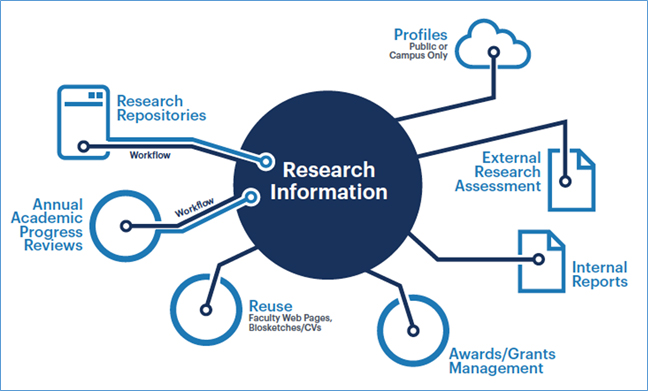Familiar roles, new opportunities
Research Information Management—RIM—is the aggregation, curation, and utilization of information about research. These activities already intersect with many aspects of your library’s services. But, as OCLC’s Lorcan Dempsey wrote in a 2014 blog post on the subject, only recently have we been treating RIM:
[As] a new service category … the integrated management of information about the research life cycle, and about the entities which are party to it.
As such, OCLC has been researching and writing about the ways that libraries are becoming leaders in this important trend. Our position paper, Research Information Management: Defining RIM and the Library’s Role, is a good place to start if you want the “big picture” about RIM and libraries.
The publication helps libraries and other institutional stakeholders better understand how institutions are adopting research information management practices, driven by many different uses, such as support for expertise in discovery, open access policies and compliance, faculty activity reporting workflows, and research assessment activities. In it we identify four major ways in which libraries can add value to this complex ecosystem:
- Publications and scholarship expertise
- Discoverability, access, and reputational support
- Stewardship of the institutional record
- Training and support
Why RIM? Why now?
Globalization, intense competition, institutional rankings, and the need for improved data for decision support are driving RIM adoption. In tandem with activities by publishers and funders, libraries can help connect a complex scholarly communications landscape of researchers, affiliations, publications, datasets, grants, and projects.
Research Information Management is valuable to research institutions because it provides opportunities for new insights at the departmental, faculty/college, and institutional levels. They can also tell a story about major research issues and can help to reliably connect a complex scholarly communications landscape of researchers, affiliations, publications, datasets, grants, projects, and their persistent identifiers.
RIM offers libraries new opportunities to support institutional and researcher goals. Click To TweetAnd if a story needs to be told about the awesome research your institution does, who better to tell it than you?
Universities, national laboratories, medical centers, and other institutions that conduct research are in need of libraries’ help. RIM systems enable organizations to collect data from different systems, combine it with external information (such as metadata harvested from aggregators and indexes), and provide a richer view of the research activities of an institution and its departments and faculty.
The insights provided by a good RIM program can help your institution develop new insights around how and where your departments, colleges, and faculty are most successful … and where improvements can be made.
And from there, you are better able to tell your institution’s story about major research efforts, their impact, and collaborative strengths. You are likewise helping your researchers manage their own individual scholarly reputations.

Librarians as researcher advocates
Librarians have always educated and supported researchers, traditionally by providing discovery services and access to research materials. Support for researchers and other users of the RIM system is an extension of that mission and can complement (or positively contrast with) other campus units whose core missions are more likely to be compliance, reporting, or academic affairs.
Library involvement can help ensure that the needs of researchers are considered within this ecosystem. As such, many libraries assume the management of RIM training and support, offering workshops, presentations, and guidance to the researchers, faculty, and students who use RIM infrastructures. Librarians can also train researchers to import publications data from publication indexes and reference management tools, to link their profiles with unique identifiers like ORCID, and to use and understand impact indicators.
What can you do? What are you already doing?
To help us (and your colleagues) get a better grasp on a baseline for libraries and RIM, we’re partnering with euroCRIS on a “current practices survey.” We invite participation from universities, research institutes, and other organizations supporting research and research management. And we encourage your institution to participate in this survey regardless of the status of your RIM implementation.
Please take the survey. As librarians, we have the opportunity to apply our talents, tools, and insights to an entirely new and growing knowledge management process that very much overlaps with our expertise and professional values. And it’s a great opportunity for you and your library to have an even greater impact on the success of your institution’s research goals.



Share your comments and questions on Twitter with hashtag #OCLCnext.